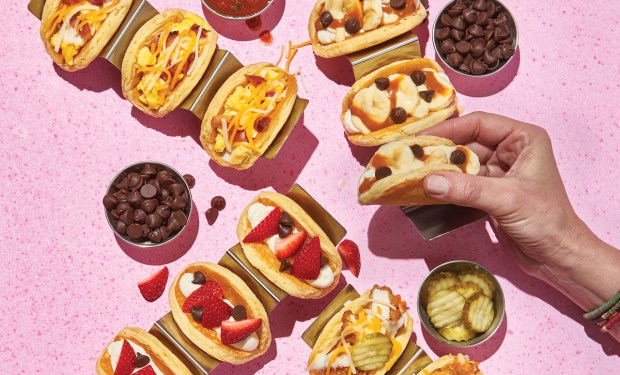IHOP CMO: Rise of off-Premise Demands More Portable Menu Options

As digital ordering has cemented its role in the years since 2020 as a key, permanent part of the restaurant industry, brands are being challenged to rethink their menus to meet the needs of the connected consumer.
In an interview with PYMNTS following the release of IHOP’s off-premise-friendly limited-time pancake tacos, Chief Marketing Officer Kieran Donahue noted that off-premise’s rise to prominence is challenging restaurants to create more portable foods.
“In the industry, there is an ever-increasing demand for convenient, craveable off-premise options,” Donahue said. “With off-premise sales accounting for over 20% of our business, we continue listening to our guests and innovating IHOP’s menu to provide appealing, craveable options that are portable and delivery-friendly, and can be enjoyed in-restaurant or on-the-go. When we’re developing menu items, we check for portability.”
Twenty percent is relatively low compared to the restaurant-wide, cross-segment average. According to data from PYMNTS’ study “Connected Dining: Rising Costs Push Consumers Toward Pickup,” which drew from a survey of more than 2,100 U.S. consumers earlier this year, just 10% of restaurant customers reported having placed their last order for delivery, while 39% had done so for pickup.
One of the key challenges for restaurants now is making sure that those off-premise sales come through their direct channels rather than through third-party aggregators, such that restaurants can retain the revenue from the sales, control the customer interactions and gain valuable transaction data.
Most restaurant orders are placed directly. Research from PYMNTS’ study last year, “The 2022 Restaurant Digital Divide: Restaurant Apps and Websites in the Spotlight,” which drew from a survey of nearly 2,000 U.S. consumers, showed that 16% of consumers primarily order food via restaurants’ direct ordering channels such as their website or their app, while only 8% mainly order food via third-party aggregators.
Yet aggregators still play a key role in today’s restaurant industry, and eateries continue to be forced to rely on them. Even those that held out for years are joining the fold, with Domino’s the latest to give in and announce it is getting on Uber Eats’ marketplace.
IHOP, for its part, has had some success driving direct ordering with its loyalty program. Donahue noted that, since the program’s launch in April 2022, more than 5.5 million customers have joined, and members of the program account for “around 5%” of the brand’s sales.
“We have … seen growth across our owned channels thanks to our loyalty program, with many orders coming directly through the IHOP app and online,” Donahue said.
In addition to considering portability when designing menu items, IHOP has also, Donahue explained, “prioritized improving our to-go packaging, back-of-house operations, and getting food from the kitchen into the hands of third-party delivery operators,” as well as implementing new digital capabilities such as Flybuy geofencing for pickup orders.
Looking toward the year ahead, Donahue said there will be “more technology investments to streamline our operations both in restaurants and off-premise.”

